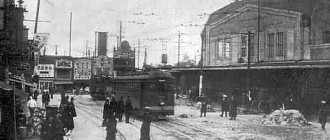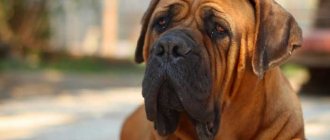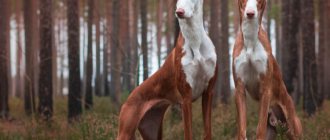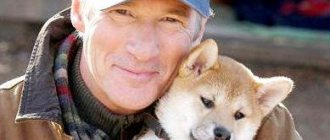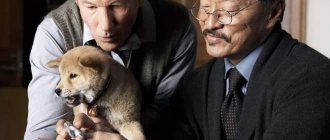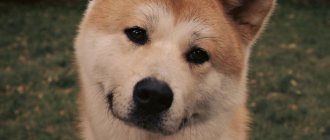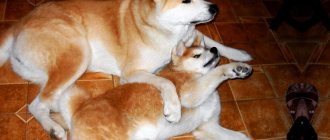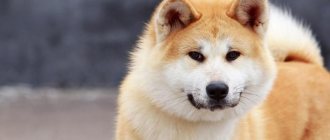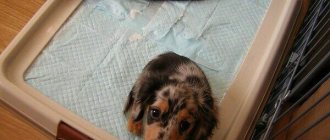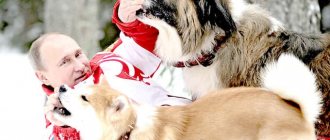Still from the film about Hachiko
Almost every person who plans to get a dog dreams of eventually getting a devoted friend for many years.
Most movie fans and dog lovers remember the film starring Richard Gere about the loyalty of a four-legged pet.
And this is not the only film that talks about the love of a dog for its owner. Hachiko's story is not a fictional scenario; all the situations described actually happened in Japan.
Let's plunge into the world of devotion and fidelity, true friendship between man and animal. Who is Hachiko? What breed of dog? We will talk about this further.
For information
The film, made by Americans, amazed many people. Today there is even an expression “Loyal like Hachiko” or “Waiting like Hachiko.” The legendary dog from the film has a real prototype, but it would be more correct to call him Hachiko, because such a nickname is as close as possible to the Japanese language. But still the whole world knows and remembers him under the name Hachiko.
Meet the owner
The real story of the dog Hachiko took place in Japan in the first half of the 20th century. The dog-legend of his and our time was born in 1923, on November 10, in Akita, which is a Japanese prefecture.
A farmer whose dog was whelped decided to give a gift in the form of a puppy to a professor named Hidesaburo Ueno who worked at the University of Tokyo - this is the person for whom the dog never waited. The professor called his new friend “Eighth,” translated as Hachiko. The real story of this dog, which amazed the whole world, began on the day he met his owner.
Description and standard of the Akita Inu breed
Akita Inu is a dog with a strong, graceful build and belongs to large breeds. According to the ICF classification, it is included in the Spitz group. The height of Akita Inu reaches 65 cm, females are slightly smaller - up to 61 cm. Girls have a more slender and elongated body, boys have an almost square physique. The weight of an Akita Inu male is 45-59 kg, females 32-45 kg.
Head
The head is medium in size, consistent with the proportions of the body, elongated, reminiscent of a fox. The fur on the face is short, a white pattern in the form of a mask is required. The forehead is wide and flat, the stop is clearly defined, the nose is pointed. The jaws are strong, have a scissor bite, and the lips fit tightly. The nose is black. The ears are small, triangular, pointed at the ends. Set wide apart, erect in an adult dog. They do not rise immediately; in puppies they are lowered. The ears are movable and, when at rest, point slightly to the sides. The eyes are dark and located close to the nose. The outer corners are slightly raised. The fur on the face is fluffy, making the eyes appear small. But the look is insightful and intelligent.
Body type
The physique is muscular and strong. The neck is short, with a small collar. Possible folds and loose skin. The chest is wide, slightly concave, the stomach is well tucked. The back is straight, short, the loin is wide. The tail is thick and fluffy. Usually rolled into a ring or thrown over the back. Never straightens completely.
Limbs
The limbs appear short in relation to the body. They are straight, parallel, muscular. The front legs are spread wide, the hind legs are shifted. The dog can jump high. Moves easily and quickly. The toes are closed and very strong. Thanks to this, Akitas swim very well. The photographs show the appearance features:
Features of wool
The coat is short, up to 5 cm long, straight and very thick. Because of this, dogs do better in cold climates. There is a soft fluffy undercoat, the guard hair is hard, two-layered. Longer at the withers, tail and hind legs.
Akita Inu colors
One color of these dogs is popular among Japanese Akita Inu breeders. They should be fawn with white areas. The color is heterogeneous, in dark areas the top layer is red. The undercoat is completely white. There should also be white markings on the chest, neck, belly, legs, nose and inside of the tail. Several more colors are recognized as standard:
- sesame or black-brown with white markings;
- pure white Akita Inu, red hair on the back is allowed;
- brindle - black stripes on the standard color, rare;
- spotted;
- black.
Photos of the main colors of Akitas:
Longhair
Sometimes there are long-haired Akita Inus. The standard does not recognize such individuals, classifying long hair as a fault. But such a gene is recessive, that is, a long-haired puppy can appear from ordinary parents. Researchers believe that it appeared due to the fact that Sakhalin huskies were used to restore the breed.
Characteristics of American Akita Inu
This breed variety appeared after World War II. American Akitas were bred in the USA from puppies brought by the military. They chose the more powerful large representatives of the breed. They were crossed with German shepherds and mastiffs. Therefore, the resulting dogs were slightly different from purebred Japanese Akitas. They began to be called “big Japanese dogs” or American Akita. Now these are two different breeds; they were officially separated in 1999. American Akitas are not recognized in Japan. Despite their common origin, they have the following differences from ancient dogs:
- larger, bear-like skull;
- height up to 70 cm, weight 65 kg;
- colors are allowed: black and white, piebald, spotted, brindle;
- the coat may be long;
- are more flexible in nature.
The pictures show the difference between American Akitas and Japanese ones:
Photo of American Akita Inu
Photo of an American Akita Inu with long hair
Photo of American Akita Inu
Every day, like clockwork
From the day they met, man and dog became inseparable. The professor adored his dog, but not as much as the dog adored him. Hachiko was always nearby, except for the time that Hidesaburo Ueno spent at work.
The true story of the faithful dog Hachiko says that the dog followed his owner to Shibuya Station, accompanying him to the city for work. After that, he went home, but at exactly three o’clock in the afternoon he again stood at the station, waiting for his man. This went on day after day.
When the owner didn't wait
The real story of Hachiko would not have become known to the whole world if the disaster had not happened. The dog's life changed dramatically on May 21, 1925, when for the first time in his life he did not wait for the professor. No, he didn’t leave, the professor didn’t get off at another station, the man simply disappeared completely! At the university, Hidesaburo Ueno had a heart attack, the doctors could not do anything. On this day, Hachiko became an orphan; at that time the dog was only one and a half years old.
Despite the fact that the dog no longer noticed such a beloved person at the station, he still did not give up hope. Every day Hachiko came to a familiar place and waited, sadly peering into the faces of passers-by.
This behavior of the dog could not go unnoticed. The professor's friends and relatives tried unsuccessfully to place him in their homes, the dog simply ran away and, as before, went to the station, expecting to see his owner. Hachiko waited for the professor until late in the evening, and spent the night on the porch of his house, in which strangers were already living.
External links [edit]
| Wikimedia Commons has media related to Hachiko . |
- "Behind the film 'Hachi: A Dog's Tale'". Vicky Shigekuni Wong. Retrieved November 29, 2012. A site with numerous photographs of the real Hachiko during his life, at the end of his life, his favorite professor, and the people who came to care for Hachiko.
- Skabelund, Aaron Herald (23 September 2011). "Dog Imperialism". Berfroi. Retrieved October 28, 2011.
| Authoritative control |
|
Popularity
At the station the dog was fed by railway workers and traders, each of them sympathized with the dog, worried about its fate, but admired such incredible devotion and perseverance.
All of Japan learned the real story of Hachiko only in 1932, when one of the largest newspapers decided to publish an article about the dog and its photo. The publication talked about a dog that is still waiting at the station for its owner, who died seven years ago.
Such a story could not leave a single resident of Japan indifferent; it won the heart of everyone. After the publication of a newspaper with the dog’s story, tourists even from distant cities began to come to Shibuya station just like that. Some just wanted to see Hachiko, some took pictures with him, some really helped - with food and gentle stroking.
Links[edit]
- "Hachiko: The Akita that became a symbol of fidelity". Retrieved July 25, 2016.
- "Incredible Facts". Retrieved March 1, 2014.
- "Hollywood is the latest to fall in love with the tale of Hachiko". The Japan Times
. Kyodo News. June 25, 2009. Retrieved September 25, 2014. - "K(公)". Kotobank.
- The dog has been faithfully awaiting the return of its owner for the past 11 years. Story published August 18, 2007 by Chris W. (cgull) in Lifestyle of Digital. Accessed July 8, 2008. Archived November 3, 2013, at the Wayback Machine.
- Buie, Barbara. Akita, Treasure of Japan, Volume II.
Hong Kong: Magnum Publishing, 2002, p. 5. ISBN 0-9716146-0-1. Accessed via Google Books April 18, 2010. - Skabelund, Aaron Herald (23 September 2011). "Dog Imperialism". Berfroi. Retrieved October 28, 2011. Quote journal requires |journal=(help)
- "Hollywood is the latest to fall in love with the tale of Hachiko", The Japan Times
, June 25, 2009. - "Mystery solved in death of legendary Japanese dog". yahoo.com
. Archived from the original on March 5, 2011. Retrieved October 2, 2015. - "Worms, not skewer, made in Hachiko". The Japan Times
. March 4, 2011 - Opening of the National Museum of Nature and Science's completely refurbished Japan Gallery "In addition to much-loved examples from previous permanent exhibitions such as Hachiko's trusty dog, Antarctic explorer Jiro's dog and Futabasaurus suzukii, a plesiosaur native to Japan, the new exhibits include a wide range of newly introduced items." 2007 National Science Museum, Tokyo. Accessed November 13, 2007
- Kimura, Tatsuo. "The Story of the Akita Dog". Akita training center. Retrieved May 6, 2011.
- "Stuffed animal of Hachiko (and other famous dogs)". pinktentacle.com
. August 17, 2009. Retrieved July 30, 2013. - Jump up
↑ Drazen, Patrick (2011).
Gathering of Spirits: A Japanese Ghost Story: From Folklore and Kabuki to Anime and Manga. iUniverse. paragraph 101. ISBN 978-1462029426. Aoyama Cemetery contains a monument to Hachiko on the site of Professor Ueno's grave. Some of Hachiko's bones are reportedly buried there, but in fact Hachiko can still be seen, stuffed at the National Science Museum. - Newman, Leslie. Hachiko is waiting
. Macmillan, 2004. 91. Retrieved from Google Books on February 25, 2011. ISBN 0-8050-7336-1, ISBN 978-0-8050-7336-2. - "Visit Hachiko Odate's hometown, Akita!" . thegate12.com
. December 12, 2022. Retrieved December 24, 2022. - "Akita Dog Museum". visitakita.com
. Retrieved December 24, 2022. - "Akita Dog Museum in Odate". japantravel.com
. July 23, 2013. Retrieved December 24, 2022. - "Attractions ~ Hachiko Statue ~ Woonsocket". iheartrhody.com
. Retrieved December 24, 2022. - ↑
"Hachiko, Japan's most loyal dog, is finally reunited with her owner in a touching new statue in Tokyo".
rocketnews24.com
. February 11, 2015. Retrieved August 2, 2015. - "Tokyo Hachiko Statue University - Tokyo - Japan Travel - Japan Travel Guide and Tourist Map". JapanTravel
. Retrieved April 9, 2022. - American Kennel Club (credited author): The Complete Book of Dogs: Photography, History, and Official Standard of Every Breed Cleared for AKC Registration, and the Selection, Training, Breeding, Care, and Feeding of Purebred Dogs
, Howell Book House, 1985, p. 269. ISBN 0-87605-463-7. - Ruthven Tremain, The Animals' Who's Who: 1146 Famous Animals in History, Folk Culture, Literature, and Laura
, Scribner, 1984, p. 105. ISBN 0-684-17621-1. Accessed via Google Books August 21, 2008. - ↑
74th Commemoration of Hachiko at the Hachiko Statue on YouTube - ↑
Retrieved November 13, 2022 - https://www.city.shibuya.tokyo.jp.e.mu.hp.transer.com/est/kyodo/index.html
- Ohmoro, Kazuya (2012-06-16). "The last photograph of Hachiko's faithful dog is on display at Shibuya Museum". Asahi Shimbun
. Archived from the original on 2012-07-18. - Yomiuri Shimbun (2015-11-05). "Rare photo shows Hachiko relaxing alone at Shibuya Station". Yomiuri Shimbun
. Archived from the original on 2015-11-14. Retrieved November 10, 2015. - "Remains of Hachiko's master's wife, buried with her husband, the famous faithful dog". Mainichi Daily News
. 2016-05-20. Retrieved April 10, 2022. - "In love and death - the Nation". Nation
. Retrieved April 10, 2022. - "もうひとつの「ハ公」物語 - 読む・考える・書く" .読む・考え・書く
(in Japanese). 2016-05-20. Retrieved April 6, 2022. - ^ ab Hachikō Monogatari on IMDb.
- Ann Tereska Ciecko, Contemporary Asian Cinema: Popular Culture in a Global Frame
, Berg Publishers, 2006, pp. 194-195. ISBN 1-84520-237-6. Accessed via Google Books August 21, 2008. - Company credits for The Hachiko Story (1987) from the Internet Movie Database
- Hachiko: A Dog's Tale on IMDb
- For the film "Hachi: A Dog's Tale" Vicki Shigekuni Wong accessed online October 1, 2013
- Ganzert, Robin; Anderson, Allen; Anderson, Linda; Becker (Foreword), Marty (Foreword) (September 16, 2014). Animal Stars: Behind the Scenes with Your Favorite Star Actors (Hardcover) (1st ed.). New World Library. p. 296 p. ISBN 978-1608682638. Retrieved November 20, 2015.
- Publishers Weekly Roundup: 05/17/2004, accessed online 10/1/2013.
- Hachiko Waits archived 2015-09-29 in the Wayback Machine various editions of the book on the author's website accessed October 1, 2013
- Hachiko Waits is now available in paperback. Published by Square Fish, 2008. Archived September 29, 2015 at Wayback Machine ISBN 0-312-55806-6
- The Story of Edgar Sawtell: Reviews.
- Lifton, Betty Jean; Hosoe, Eiko, Taka-chan and Me: A Dog's Journey to Japan
, New York Review of Books, 1967. - "Tommy Telugu Movie Review, Rating". APHerald [Andhra Pradesh Herald]
. Retrieved October 10, 2022. - Futurama Live! Post-show with Billy West, Maurice LaMarche, Matt Groening and more! . YouTube
. September 6, 2013. Retrieved October 2, 2015. - fremantle.wa.gov.au Archived 16 April 2014 at the Wayback Machine.
- Buggy Clown Versus!! Bugs Kaizoku-Dan (Against!! バギー海賊団) ISBN 4-08-872544-1
Death of Hachiko
The faithful dog spent every day at the station for nine years! During this time, many tried to shelter him, but Hachiko did not recognize a single person as his master and hurried to the station to wait for his only person!
The body of the deceased hero was found near Shibuya Station. As it was established, the cause of the dog’s death was cardiac filaria. The dog was not hungry, this was proven when, during the autopsy of the corpse, several pieces of yakitori were taken out of the stomach - this is a Japanese dish made from the meat and entrails of chicken.
Hachiko died at the age of 11 years and 4 months, of which he had known his owner for only a year and a half, and for the subsequent time he waited unsuccessfully for him at the place of separation. Death took the dog in 1935, on March 8. Until this time, no one had been able to stop the dog’s attempts to come to the station, and not a single person had captured his huge dog’s heart!
The death of the faithful dog caused a real resonance in the country, and the next day was designated as national mourning.
Content
- 1 life 1.1 Publication
- 1.2 Death
- 2.1 Bronze statues
Monument in honor of the legend
The first monument to a dog named Hachiko was erected during his lifetime, almost a year before his death - on April 21, the hero himself was present at the opening of the monument.
The Second World War forced the authorities to remove the monument and melt it down for the needs of the Japanese army. But they didn’t forget about the dog and returned a copy of the monument to its original place in 1947.
The second monument is less known; it was erected in the city of Odate on the station square. Unfortunately, the Second World War took him too for the needs of the army. But again, the copy was installed in 1987.
Today, the monument to the dog Hachiko is not only memories of the dog, but also a tribute to the devotion and loyalty of the Akita Inu breed. Surely it is impossible to find more popular places for appointments than the square where there is a monument to the legendary faithful dog Hachiko, whose real story amazed the whole world with its drama!
Impact on culture
- Hachiko's story was the basis for the 1987 film The Story of Hachiko (ハチ公物語) and the 2009 remake Hachiko: A True Friend.
- There is a reference to the story of the dog Hachiko in the Jurassic Bark episode of the Futurama animated series. In it, the main character Fry, before he was accidentally frozen and sent to the future, fed a stray dog who was, in his words, “one of his only friends.” While Fry was frozen, the dog waited for him outside the pizzeria where Fry worked throughout his life. In the same episode, Fry finds the remains of his dog and tries to resurrect him.
- The Hachiko Monument is the centerpiece of one of the missions in The World Ends with You
for Nintendo DS. There you need to cleanse the statue from the curse associated with the plot of the game. It also mentions the so-called Hachiko-fest - an annual pilgrimage to the Hachiko monument, known throughout Japan.
The remains are in the museum
The people of Japan were not ready to say goodbye to Hachiko forever, because such a dog no longer exists. Therefore, after the death of the dog, they made a stuffed animal of him, so that descendants could also see him, remember, and not forget the history of this devoted dog.
You can see the real Hachiko at the Tokyo Art Museum. Despite the long history of the story, the flow of tourists to the museum does not stop, and everyone goes there to see that same dog in person.
But the stuffed animal is just a dog’s fur coat. The rest of his remains were cremated and buried. The faithful dog's grave is located in Tokyo at the Aoyama Cemetery in the Minato-ku district.
